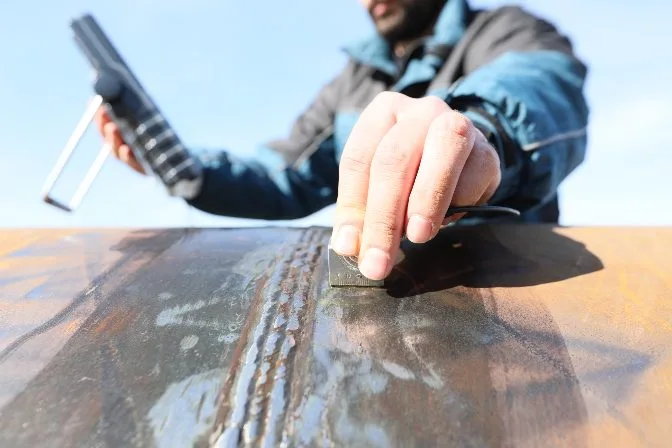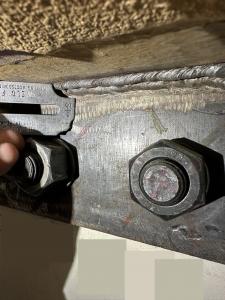The Ultimate Checklist for Welding Inspection Gilbert Arizona: Ensuring Safety and Precision
Checking Out the Relevance of Welding Assessment in Industrial Applications: Guarding Against Failures and Enhancing Longevity
Welding inspection serves as a vital line of defense in commercial applications, ensuring the architectural honesty and reliability of welded components. By systematically determining flaws such as porosity and insufficient combination, evaluations not only stop failings yet also extend the lifespan of crucial possessions.
Role of Welding Examination
Welding assessment functions as a vital secure in industrial applications, making certain that bonded frameworks meet specified standards of quality and security. This procedure includes a systematic evaluation of welds to confirm their integrity, stamina, and conformity with recognized codes and specs. The duty of welding examination is diverse, incorporating both aesthetic assessments and non-destructive screening techniques, which may consist of ultrasonic, radiographic, or magnetic fragment testing.
Reliable welding evaluation identifies prospective concerns early, alleviating the danger of disastrous failures that can emerge from poor welds. By making certain that welds are carried out according to design specs, inspectors contribute to the overall architectural dependability and long life of parts in essential applications, such as pressure vessels, pipes, and structural structures.
Typical Welding Flaws

Among one of the most common issues is porosity, characterized by small gas pockets entraped within the weld metal. This occurs due to contaminants or improper shielding gas, endangering the weld's toughness. One more considerable problem is incomplete fusion, where the weld metal falls short to bond effectively with the base product, potentially bring about architectural weaknesses.

Fractures can also create throughout or after the welding process, often credited to thermal stress and anxieties or incorrect cooling prices. Additionally, damaging, where the base metal is deteriorated along the weld grain, can weaken the joint and is usually created by too much heat input or wrong method.
Moreover, absence of infiltration happens when the weld steel does not get to the root of the joint, leading to insufficient strength. Comprehending these common flaws is essential for examiners and welders alike to make certain that welded frameworks meet security and efficiency requirements, inevitably avoiding potential failures in commercial applications.
Advantages of Regular Assessments
Regular evaluations function as an important guard in making certain the dependability and long life of bonded frameworks. These analyses identify prospective issues and weaknesses that may jeopardize the honesty of welds, permitting timely remediation prior to concerns escalate. By executing a structured assessment regimen, organizations can considerably minimize the threat of catastrophic failures that may result in expensive downtime, devices substitute, and even crashes.
In addition, regular evaluations add to improved high quality control throughout the welding procedure. By sticking to a constant assessment timetable, business can make certain that their welding techniques fulfill established quality benchmarks and ideal techniques. This not only promotes a culture of accountability but also urges continual enhancement among welding workers.
Furthermore, routine evaluations facilitate better upkeep preparation. By determining wear and tear early, companies can purposefully set up repair services and substitutes, decreasing disturbance to operations. This proactive approach inevitably causes prolonged property life-span and enhanced overall performance.
Finally, a commitment to regular examinations can improve a firm's track record in the market. Stakeholders and customers significantly worth companies that focus on security and top quality, therefore improving trust and potentially leading to enhanced organization opportunities.
Market Standards and Rules
Following sector standards and guidelines is a basic aspect of welding assessment that enhances the benefits of regular examinations. These standards, established by organizations such as the American Welding Culture (AWS) and the American Culture of Mechanical Engineers (ASME), offer a framework for finest techniques in welding procedures, products, and assessment techniques. Conformity with these laws guarantees that welds satisfy the called for top quality and security standards, dramatically minimizing the threat of architectural failures.
Governing bodies like the Occupational Safety and Health And Wellness Administration (OSHA) further apply guidelines that protect employees and the environment throughout welding procedures. By following these developed requirements, industries can enhance the dependability of their parts and structures, guaranteeing they do as planned under different operational conditions.
Additionally, adherence to market requirements fosters consistency in quality assurance, click here for info assisting in smoother communication among stakeholders and regulatory agencies. This placement not just lessens obligation risks but also boosts the credibility of companies in affordable markets. Welding Inspection Gilbert Arizona. Eventually, compliance with welding criteria and laws is not just a legal obligation; it is a vital financial investment in security, performance, and lasting operational success
Future Trends in Welding Inspection
As markets continue to evolve, the future of welding examination Read Full Article is poised to incorporate sophisticated technologies that boost accuracy and efficiency. Among one of the most substantial trends is the fostering of automation and robotics in evaluation procedures. Automated systems can carry out inspections swiftly, minimizing human error and raising throughput in producing environments.
Additionally, the integration of expert system (AI) and artificial intelligence formulas will make it possible for predictive analytics, permitting real-time analyses and positive upkeep. By analyzing data from previous examinations, these modern technologies can determine patterns that can indicate prospective failings, therefore extending the life expectancy of bonded components.
In addition, non-destructive testing (NDT) strategies are anticipated to become a lot more innovative, utilizing tools such as drones and self-governing automobiles furnished with cutting-edge sensors. Welding Inspection Gilbert Arizona. These improvements will certainly boost the ability to examine hard-to-reach or harmful areas without endangering safety
Additionally, the fad in the direction of digitalization will certainly lead to improved data management systems that facilitate much better tracking, reporting, and compliance with market requirements. In summary, the future of welding assessment is defined by technical improvements that assure to considerably improve reliability, safety, and operational performance in numerous commercial applications.
Verdict
To conclude, welding inspection offers an essential feature in making certain the honesty and durability of bonded frameworks across various industrial applications. By identifying issues such as porosity and insufficient combination, routine evaluations play a significant duty in danger mitigation and quality control. Adherence to sector requirements and policies further boosts functional safety and integrity. As improvements in innovation remain to progress, the future of welding evaluation promises boosted accuracy and performance, eventually adding to the long life of critical infrastructures.
Welding inspection offers as an important line of protection in industrial applications, making sure the architectural integrity and dependability of bonded components.Welding assessment offers as a crucial secure in industrial applications, making certain that welded structures fulfill defined standards of high quality and safety and security. Ultimately, the role review of welding inspection is important in advertising safety and security, enhancing performance, and securing financial investments in commercial framework.
These standards, developed by companies such as the American Welding Culture (AWS) and the American Culture of Mechanical Designers (ASME), provide a framework for finest methods in welding procedures, products, and assessment methods.In final thought, welding assessment offers a crucial feature in making certain the integrity and resilience of welded structures throughout numerous commercial applications.